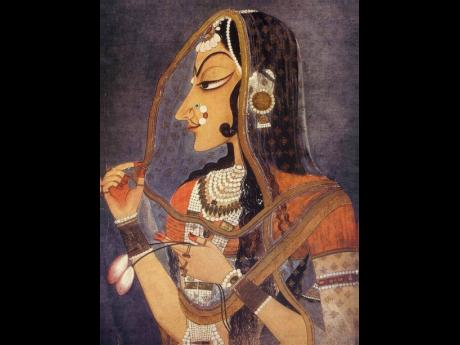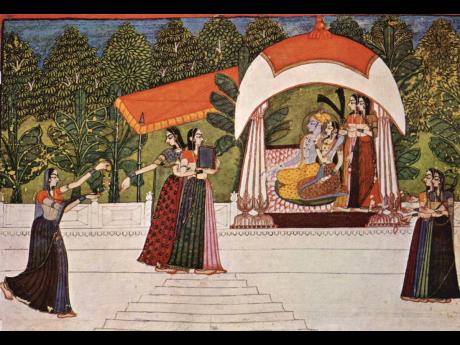Radha Kishangarh – the Mona Lisa of India
Queen Nefertiti of Egypt, who is immortalised in the 20th century remarkable archaeological find of her painted bust that now adorns the Cairo Museum as a world-renowned ancient work of art, is often compared for her beauty to Leonardo da Vinci’s famous painting, Mona Lisa, which saw light of the day nearly three millennia later during 1503-07 AD and is housed in the Louvre Museum in Paris.
While these two works of art hug most of the limelight in celebration of a woman’s grace and beauty, there is another one – Radha Kishangarh, which also remained wrapped in anonymity for nearly two centuries and has come to be recognised as an epitome of India’s feminine beauty.
Vinci’s Mona Lisa has fascinated and intrigued art-lovers around the world with her mystic and enigmatic smile. Researchers remained ever-engrossed in solving the mystery of the real identity of the woman in Vinci’s life, who had modelled for the painting, and concluded in 2005 to have definitively traced her to one Lisa del Giocondo (1479–1542), a mother of five children, who lived in Florence and Tuscany, in Italy. But, during the study of the painting with the help of X-rays and other advanced technology, they have been able to see that the painting has undergone several restorations and it has three versions of Mona Lisa hidden underneath. Thus, the lateral layers of paints brushed over the previous ones perhaps prove that the model’s physical appearance or the painter’s vision underwent a change during the slow pace of accomplishment of this great piece of art, or were simply borne to the efforts in time on its restoration. Similarly, discovery of other contemporary limestone statues and plaques in relief-work depicting truthfully the facial flaws and other corporal limitations of Queen Nefertiti raise fingers at the sculptor’s generosity towards propping her to perfection in her life after death in 1330 BC, at age 40. Thus, doubts are raised on the fabled beauty of Mona Lisa herself, and the Painted Queen likened to her.
YOUTHFUL BEAUTY
The Indian version, Radha Kishangarh, however, captures a woman’s youthful beauty, charm and grace at their best, and this miniature painting done in 1778 remains unblemished till date.
A long chiselled nose, little quivering lips, tranquillising lotus eyes, bow-shaped eyebrows and a broad forehead on an elliptical fair face supported by a tender neck. This is the ‘Radha Kishangarh’, a historical personality of the 18th century, immortalised by an artist who himself remains shadowed by obscurity even though his masterpiece found world acclaim eventually. Bani-thani ki Chavi or image of a well made-up belle, that was the name given to the portrait of a royal singer by the miniature artist Nihal Chand of the Kishangarh School of Art in Rajasthan, India, when he painstakingly captured her image in 1778, displaying the Indian feminine fineries at their best, which was rechristened later as the ‘Mona Lisa of India’. The Kishangarh School of Art is notable for its elongated style, with “arched eyebrows, lotus-like elongated eyes and pointed chin” a highly idealised facial form reminiscent of Indian sculpture art.
Such a fascinating work of art remained buried in anonymity for nearly two centuries till it was brought to light in 1952 from the darkness of the royal ‘toshakhana’ (repository of precious articles), by an European art-lover, Eric Dickinson. It was only after it was evaluated in glowing terms by renowned art critics that this miniature painting received worldwide appreciation and its deserving place among the best art creations of the world. Bani-thani ki Chavi is a tribute to a love story – the passion of the 18th century King Sawant Singh of Kishangarh, near Ajmer in the western Indian state of Rajasthan for a talented and beautiful commoner for whom he renounced his royalty.
Sawant was a prince when his stepmother visited the Moghul court at Delhi, and was so impressed by the golden voice and singing abilities of a teenage girl in the royal court of King Mujammad Shah Rangila that she took her in own personal service and brought her along. The girl, then at the prime of her blossoming youth, not only wooed the hearts of all those who were ever privileged to listen to her devotional songs, rendered each day in praise of Lord Krishna, but also mesmerised those who saw her shimmering self, covered with generous make-up and tasteful adornment from the forehead down to the toes.
FANCY WITH MAKEUP
It was her fancy with the makeup that earned her the title of ‘Bani Thani ji’. The physical charm and the traits of similar artistic frame of mind swayed the young Sawant Singh, who was already married by then. Sawant’s intense love for the singer faced tough resistance from every possible quarter and he was frustrated to such an extent that he gradually lost all interest in governance of the state and shunned his hitherto affluent lifestyle. Finally, in 1757, he abdicated his kingdom and moved on with his beloved to the holy place Brindavan, where in the mythological past Lord Krishna had lived and charmed ‘gopis’ or the female cowherd friends. Sawant composed about 75 verses under the pseudonym ‘Nagridas’ and his compositions, like Utsav Mala, Bihari Chandrika, Rasik Ratnavali and Grisham Vihar, are cherished even to this day. Singer Bani Thani also sharpened here her poetic skills, too, and wrote verses with the pseudonym ‘Rasik Bihari’, rendering these in her golden voice to add to the religious fervour of the devotees, who thronged them in hundreds each day. In his verses in the praise of Lord Krishna, Sawant Singh portrayed himself as Krishna and his beloved Bani Thani as his paramour, Radha.
Inspired by these very verses, the artistes of Kishangarh created miniature paintings embodying their popular king and his paramour as the divine couple. While at Brindavan, ‘Bani Thani’ breathed her last in 1763. Shocked by her separation, Sawant followed her soon to the heavenly abode in 1764.
While ‘Radha Kishangarh’ herself is immortalised as an uncrowned queen of people’s hearts, her world-famous miniature painting in 19” x 14” (48.8 cms x 36.3 cms) size forms part of the personal collection of Maharaja Brajraj Singh of Kishangarh. The Indian Philately Department has recognised the magnificence of this miniature painting by reproducing the artistic fineries in a commemorative postal stamp in 1973, bringing its glory to the masses. Yet, in 2009, the Philately Department cast it in silver ingot layered with 24 carat gold, paying a befitting golden tribute to this Mona Lisa of India.
Bimal Saigal is a former Indian diplomat. He served as the second secretary at High Commission of India in Jamaica in 2006.



